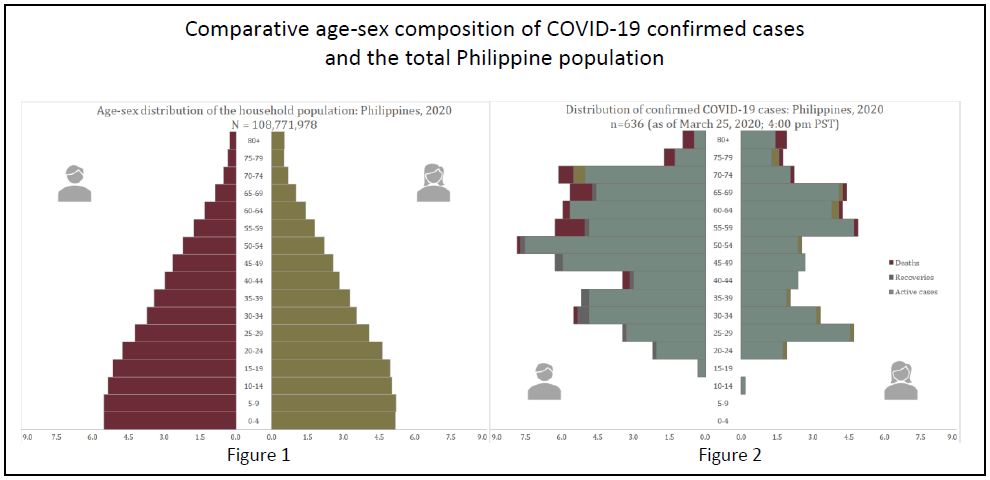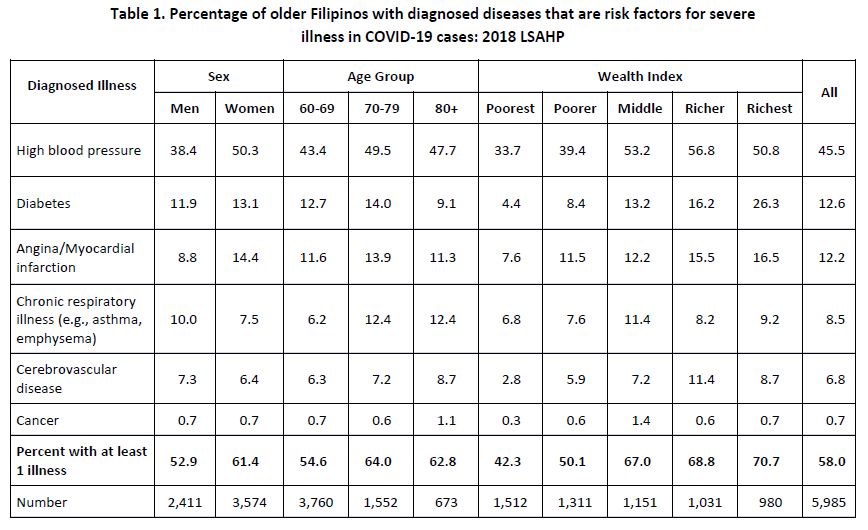
COVID-19 and the Older Filipino Population: How Many Are at Risk?
The University of the Philippines Population Institute (UPPI) in collaboration with the Demographic Research and Development Foundation (DRDF) are sharing results of their demographic studies to provide the Philippine context on the possible effects of the coronavirus disease (COVID-19) pandemic. In both the UPPI and DRDF websites, we are publishing a series of research briefs focusing on various aspects of Filipino lives that are affected by COVID-19, in both the short and long terms.
Download PDF here.
In this research brief, our analysis aims to put in context the latest official data on the continuing epidemic by comparing the characteristics of the known cases with the general population of the Philippines. In doing this, we answer such basic questions as, what are the ages most affected by this disease, which sex is more vulnerable?
We first present the age and sex profile, (also known and the population pyramid) of the Philippines population projected to 2020 from the 2015 census (Figure 1). The estimated population of the Philippines in 2020 is 109 million. The bulk of the population is concentrated in the younger groups (0 to 29), with the median age at 26 years. This means that half of the 109 million Filipinos are aged below 26. By sex, the number of men is also about equal to the number of women from age 0 to 64 while there are more women than men from age 65 onward.
On the other hand, Figure 2 clearly shows the age and sex distribution of the 636 known COVID-19 positive cases on 25 March 2020. Compared with the total Philippine population, COVID 19-positive cases have an entirely different configuration and is consistent with what has been reported in other countries. Although the DOH warns that the lack of nationwide testing may skew the data somewhat to the more severe cases, the age-sex distribution of local COVID-19 positive cases fits the profile of other countries with the bulk of infections found among those in the older age groups. In the Philippine COVID-19 tracker there are no reported cases below age 10-14 (the youngest diagnosed case is a 13-year old male). The majority of the cases are in the age group 50 and above. Compared with the relative share of the 50 and older age group in the Philippines population, COVID-19 positive cases are disproportionately found in the older ages of 50 and higher. Furthermore, there is a highly imbalanced sex ratio among COVID-19 positive cases with a higher proportion of men starting at age group 30-34 and persisting to the oldest age group. Thus, compared to the total population, COVID-19 positive cases are older and have a higher proportion of men.
Likewise, of the 38 recorded deaths among the 636 COVID-19 positive cases, an overwhelming majority (89 %) are in the age group 55 and over. Figure 2 clearly shows that not only are there more cases among the older ages, the deaths are also concentrated in these age groups. There is also more male than female deaths.
Of the total COVID-19 positive cases as of 25 March 2020, 26 are reported to have recovered, 16 men and 10 women. The youngest to have recovered is 21 years old and the oldest, 76; the average age is 49.

While advanced age by itself appears to be a risk factor for severe disease, the presence of comorbidities, specifically hypertension, heart disease, diabetes, respiratory diseases or being immunocompromised in any way is another risk factor for severe disease, at any age. For older adults, these two risk factors are highly correlated as older people are more likely to have one or more of these conditions.
To get a sense of how many older Filipinos are doubly exposed to the risk of severe COVID-19, we turn to data from the 2018 Longitudinal Study of Aging and Health in the Philippines (LSAHP) 1. The LSAHP is the first longitudinal, nationally representative study of older Filipinos aged 60 and over living in community dwellings. The 2018 LSAHP baseline data covered a total of 5,985 interviews selected using a multistage sampling design. The respondents were presented a list of diseases, mostly chronic in nature and prevalent among older adults, and asked if they had been told by a doctor that they currently have that particular disease.

Table 1 shows the percentage of older Filipinos who have been diagnosed with each of the known risky comorbidities, broken down by sex, age and socioeconomic status or the wealth index 2. By far, the most common condition is hypertension with 46 percent of all older Filipinos (age 60 and over) having been diagnosed to have this condition. Another feature of the disease condition of older Filipinos is that these comorbidities are likely to occur in combination with one another. The bottom row of the table shows the percentage of older Filipinos with at least one of the risky co-morbid conditions.
In all, more than half (58%) of older Filipinos have at least one of the risky co-morbidities for COVID-19. More women (61%) than men (53%) have at least one condition. Those in the youngest age group (60-69) have the lowest percentage reporting at least one condition. By socioeconomic status, the percentage with at least one disease condition is highest among the upper 20% of the population (71%) and lowest among the poorest 20% (42%).
Applying these percentages to the estimated number of older Filipinos gives an idea about the potential magnitude of the public health problem if older Filipinos are not protected from the risk of contracting the coronavirus infection. Of the estimated 9.5 million Filipinos age 60 and above, 5.5 million have existing high-risk conditions, higher among women and among the rich segment of the population.
The number of people at risk of severe disease among older Filipinos is a strong justification to protect this segment of the population from being infected by the novel coronavirus. Having a high infection rate among older Filipinos half of whom have co-morbidities will put an intolerably heavy strain on the health care system already reeling from the existing caseload of COVID-19 positive cases, as well as contribute to a high mortality rate from the disease. Current strategies of social distancing, observance of proper hygiene should be assiduously practiced not only by older Filipinos but also by their household members.
1 The 2018 LSAHP Report may be accessed at: http://www.eria.org/publications/ageing-and-health-in-the-philippines/
2 The wealth index is a composite measure of the cumulative living standard of the household where the older person resides. This was computed using the household’s ownership of appliances and vehicles, and the characteristics of the dwelling where the older person lives such as the type of water source, sanitation facilities, and materials used for housing construction. The wealth index ranges from 1 (lowest quintile or the poorest) to 5 (highest quintile or the wealthiest).
This research brief was prepared by Josefina N. Natividad, Elma P. Laguna, Grace T. Cruz, Maria Paz N. Marquez, Maria Midea M. Kabamalan, Nimfa B. Ogena, Klarriness P. Tanalgo, Maria Karlene Shawn I. Cabaraban, Mark Ryan B. Paguirigan.
Suggested citation: University of the Philippines Population Institute (UPPI) and Demographic Research and Development Foundation, Inc. (DRDF). (2020, March). COVID-19 and the Older Filipino Population: How Many Are at Risk? (UPPI/DRDF Research Brief No. 1). Retrieved from https://www.uppi.upd.edu.ph/sites/default/files/pdf/COVID-19-Research-Brief-01.pdf.
